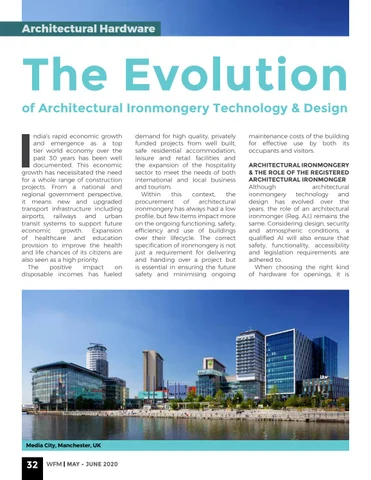Architectural Hardware
The Evolution of Architectural Ironmongery Technology & Design
I
ndia’s rapid economic growth and emergence as a top tier world economy over the past 30 years has been well documented. This economic growth has necessitated the need for a whole range of construction projects. From a national and regional government perspective, it means new and upgraded transport infrastructure including airports, railways and urban transit systems to support future economic growth. Expansion of healthcare and education provision to improve the health and life chances of its citizens are also seen as a high priority. The positive impact on disposable incomes has fueled
Media City, Manchester, UK
32
WFM | MAY - JUNE 2020
demand for high quality, privately funded projects from well built, safe residential accommodation, leisure and retail facilities and the expansion of the hospitality sector to meet the needs of both international and local business and tourism. Within this context, the procurement of architectural ironmongery has always had a low profile, but few items impact more on the ongoing functioning, safety, efficiency and use of buildings over their lifecycle. The correct specification of ironmongery is not just a requirement for delivering and handing over a project but is essential in ensuring the future safety and minimising ongoing
maintenance costs of the building for effective use by both its occupants and visitors. ARCHITECTURAL IRONMONGERY & THE ROLE OF THE REGISTERED ARCHITECTURAL IRONMONGER Although architectural ironmongery technology and design has evolved over the years, the role of an architectural ironmonger (Reg. A.I.) remains the same. Considering design, security and atmospheric conditions, a qualified AI will also ensure that safety, functionality, accessibility and legislation requirements are adhered to. When choosing the right kind of hardware for openings, it is










